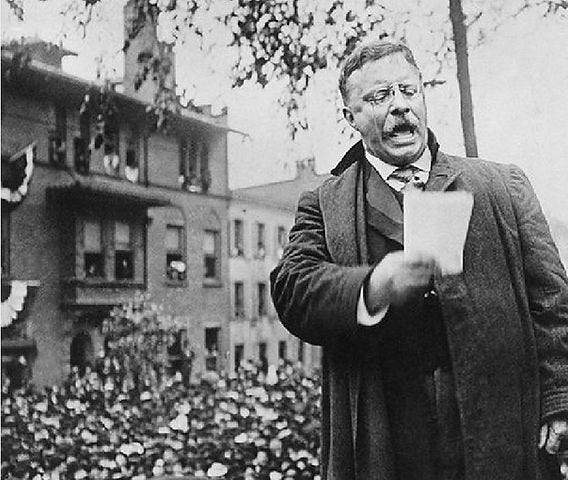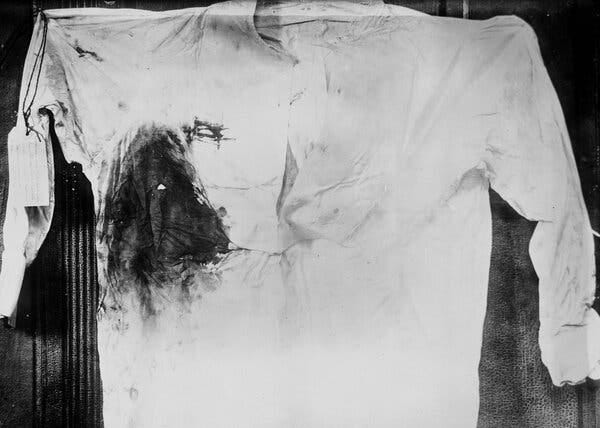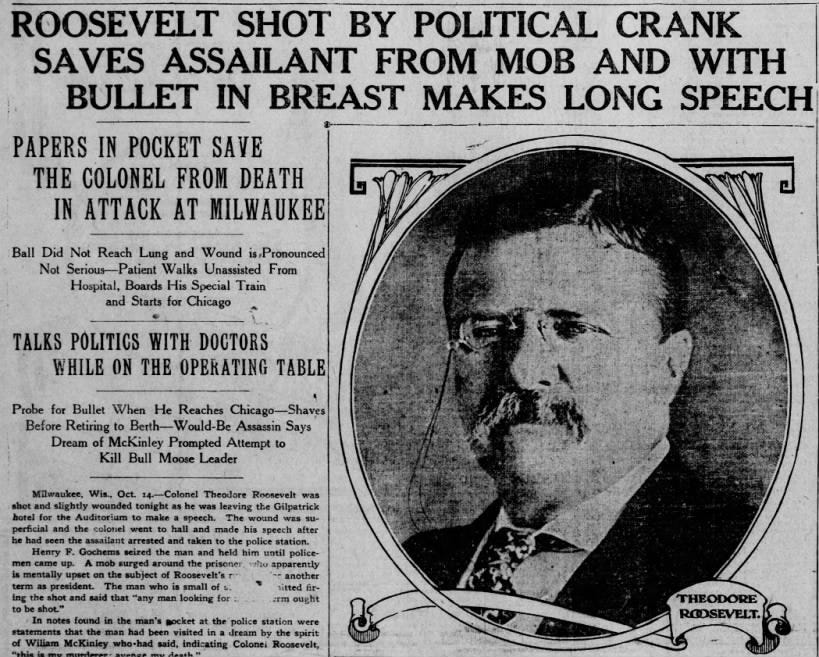October 14 - It Takes More Than One: Teddy Roosevelt and the Assassin's Bullet
Scars as Testimonies of God's Transformative Power
This is the day Theodore Roosevelt, former U.S. President and presidential candidate, was shot during a speech in Milwaukee but continued speaking for 90 minutes in 1912.
In today's lesson, we will explore how our life's challenges and scars can become powerful testimonies of God's faithfulness and transformative power. How can the wounds of our past become sources of hope and encouragement for others? What can we learn from historical figures who turned their trials into triumphs?
"I want to know Christ—yes, to know the power of his resurrection and participation in his sufferings, becoming like him in his death." - Philippians 3:10 (NIV)
This Date in History
The crack of a pistol pierced the air outside Milwaukee's Hotel Gilpatrick on October 14, 1912. Former President Theodore Roosevelt, his shirt blossoming with a crimson stain, stood firm. "He pinked me," Roosevelt declared, his voice steady despite the bullet lodged in his chest. This moment of extraordinary courage marked a pivotal point in one of America's most tumultuous elections, showcasing the indomitable spirit of a man who had once led the nation and now sought to do so again.
Theodore Roosevelt, the 26th President of the United States, had left office in 1909, confident in his hand-picked successor, William Howard Taft. However, their relationship soured as Taft's conservative policies clashed with Roosevelt's increasingly progressive vision. By 1912, the rift had grown so wide that Roosevelt challenged Taft for the Republican nomination. When the party chose Taft, Roosevelt broke away, forming the Progressive "Bull Moose" Party.
Roosevelt's campaign platform, known as "New Nationalism," advocated for increased federal regulation of the economy, social welfare programs, and conservation efforts. These ideas represented a significant departure from traditional Republican values of limited government, aligning more closely with modern liberal thought. Yet, Roosevelt's approach was uniquely his own, blending progressive reforms with a robust foreign policy and emphasis on individual character – a combination that defies simple categorization by today's political standards.
As Roosevelt arrived in Milwaukee that fateful evening, a man named John Schrank lurked in the crowd. Schrank, a 36-year-old saloonkeeper from New York, had been stalking Roosevelt for weeks. Schrank was driven by a bizarre dream in which the ghost of William McKinley ordered him to avenge McKinley's assassination which had occurred in 1901 leading to Roosevelt assuming the Presidency. As Roosevelt waved to the crowd from his open-top car, Schrank seized his moment. He fired a single shot from his .38 caliber revolver, the bullet striking Roosevelt in the chest.
The crowd reacted with shock and outrage. Roosevelt's stenographer, Elbert E. Martin, tackled Schrank while others in Roosevelt's entourage subdued him. The police quickly arrested Schrank, who would later be found insane and committed to a mental hospital.
Despite the assassination attempt, Roosevelt insisted on proceeding to the auditorium. His folded 50-page speech manuscript and steel eyeglass case had slowed the bullet, saving his life. When his aides urged him to seek immediate medical attention, Roosevelt refused, declaring, "I will make this speech or die, one or the other."
For the next nearly 90 minutes, Roosevelt delivered his address, his voice growing stronger as he spoke. He used his wound to underscore his message, declaring, "It takes more than one bullet to kill a Bull Moose." The crowd, initially skeptical, became increasingly awed by Roosevelt's display of fortitude.
Roosevelt's speech that night touched on the core tenets of his progressive platform. He advocated for women's suffrage, labor rights, and stronger regulation of big business – ideas that were radical for their time and some of which remain contentious today. Yet, he balanced these progressive policies with calls for a strong military and emphasis on civic virtue, illustrating the complex political philosophy that set him apart from both conservatives and liberals of his era.
The 1912 election ultimately saw the Republican vote split between Taft and Roosevelt, allowing Democrat Woodrow Wilson to win the presidency. Despite losing the election, Roosevelt's progressive ideas would shape American politics for decades to come, influencing both major parties and contributing to the expansion of federal power that characterizes much of modern American governance.
Theodore Roosevelt's remarkable response to an assassination attempt on that October night in Milwaukee stands as a testament to his legendary toughness and unwavering commitment to his beliefs. It also serves as a vivid illustration of a pivotal moment in American political history, when the nation grappled with questions of government's role in society – questions that continue to resonate in our political discourse today.
Historical Context
The early 20th century in the United States was a period of significant social and political transformation, often referred to as the Progressive Era. This epoch was characterized by widespread calls for reform in response to the rapid industrialization and urbanization that had reshaped American society in the latter half of the 19th century.
The 1912 presidential election unfolded against a backdrop of growing discontent with the excesses of the Gilded Age. The concentration of wealth and power in the hands of industrial magnates, coupled with widespread poverty and harsh working conditions for many Americans, had fueled a desire for change. Progressives from both major parties advocated for reforms to address these issues, though they often differed in their proposed solutions.
Theodore Roosevelt's presidency from 1901 to 1909 had already introduced many progressive reforms, including antitrust legislation, food and drug regulations, and conservation efforts. His successor, William Howard Taft, continued some of these policies but took a more conservative approach overall, particularly in his interpretation of antitrust laws.
The political landscape of 1912 was unusually fractured. The Republican Party, traditionally associated with business interests and limited government, was split between Taft's conservative faction and Roosevelt's progressive wing. The Democratic Party, under Woodrow Wilson, also embraced progressive ideals but advocated for a different approach to reform, emphasizing the breakup of monopolies rather than their regulation.
Internationally, the world was on the brink of major changes. The Ottoman Empire was crumbling, with the First Balkan War beginning just days before Roosevelt's shooting. In Mexico, the revolution that had begun in 1910 continued to rage, causing concern in the United States about instability on its southern border.
The 1912 election was also notable for the growing influence of mass media in politics. Newspapers played a crucial role in shaping public opinion, and politicians increasingly had to consider how their actions would be reported and perceived by a national audience. The dramatic nature of the assassination attempt on Roosevelt and his subsequent speech ensured widespread coverage, amplifying the impact of the event on the campaign.
This period also saw the expansion of voting rights, with several states granting women the right to vote ahead of the 19th Amendment. The women's suffrage movement was gaining momentum, adding another layer of complexity to the political landscape.
Conservation, a cause championed by Roosevelt throughout his career, was becoming an increasingly important issue. The rapid exploitation of natural resources during the industrial boom had led to growing concerns about the preservation of America's wilderness and wildlife. Roosevelt's establishment of national parks and forests during his presidency had set a precedent for federal involvement in conservation efforts, a legacy that continued to influence political discourse in 1912.
This complex interplay of social, political, and environmental concerns formed the backdrop against which the dramatic events of October 14, 1912, unfolded. Theodore Roosevelt's brush with assassination and his determined response encapsulated many of the themes of the era: the intensity of political debate, the power of individual character, and the nation's struggle to adapt its institutions to the challenges of a new century.
Did You Know?
Roosevelt's doctors later decided it was safer to leave the bullet in his chest than to remove it, and he carried it with him for the rest of his life.
Today’s Reflection
Theodore Roosevelt's survival after an assassination attempt was not just emblematic of his legendary toughness, it also offers a vivid metaphor for resilience in the Christian journey. Though shot, he continued undeterred, carrying the bullet in his chest for the rest of his life. In a similar way, we all carry the marks of our struggles and experiences. These scars, whether visible or hidden, become part of who we are and what we have to share with others. But they aren't just reminders of our pain; they can actually show God's grace and His transformative work in our lives, pointing beyond our own strength to His power at work in us.
The Apostle Paul once wrote, "I want to know Christ—yes, to know the power of his resurrection and participation in his sufferings" (Philippians 3:10). That might sound intense, but Paul understood that following Jesus means experiencing both the joys and the trials of life. For him, sharing in Christ's sufferings was a way to grow closer to Jesus, learning to rely on God's strength when human resilience fell short. Paul didn't see suffering as something to be avoided at all costs; he saw it as an opportunity to join in what God was doing in the world and to be shaped more into the image of Christ. That's a different way to look at our struggles, isn't it? Instead of seeing hardships as setbacks, we can view them as places where God is at work, molding us and drawing us nearer to Him.
Think about Jesus' scars. After He came back to life, He showed His disciples the marks on His hands and side (John 20:27). Those scars weren't hidden away—they were evidence that He had faced the worst suffering imaginable and had come out victorious. But they also represented something more: the hope of redemption and new life. Our scars can have a similar significance. They don't just testify that we've been hurt; they remind us that God has been present with us through the pain and that He has the power to redeem our darkest moments. Even when we carry wounds that still ache, they can point us—and others—to the hope we have in Christ, who brings beauty from ashes.
It's normal to wonder why we go through certain difficulties. Some wounds take time to heal, and some may always be with us, just as Roosevelt carried the bullet in his chest. Yet, we can look at our struggles with a different lens, trusting that God is working in and through them, even when we don't have all the answers. Our scars can remind us not just of where we've been, but of how God has carried us through, shaping our faith in the process. They are not signs of defeat, but markers of God's ongoing story in our lives.
When we open up about what we've been through, it gives others hope. Sharing how God has helped us in our darkest moments can encourage someone who is in the middle of their own struggle. We don't have to be completely "fixed" or have everything resolved to make a difference. In fact, it's often those who have walked through deep valleys who have the most to offer, because they can testify firsthand to God's sustaining power. Our goal isn't to come out of life without a scratch; it's to come out stronger, with a deeper understanding of who Jesus is and how He has walked with us every step of the way, even when things remain messy or unresolved.
So, as we face challenges, let's remember that we're not alone. We are sharing in what Jesus went through—both the pain and the hope. While our scars may remind us of hard times, they also point to the promise that God is still writing our story, and He's not done yet. Even in the midst of suffering, we can hold on to the hope that God is making something beautiful out of our lives, and that one day, every scar will find its place in His redemptive plan.
Practical Application
Reflect on the "scars" in your life—areas where you've faced challenges or experienced pain. Write down three of these experiences and, next to each, note how God's faithfulness was evident. Then, consider how you might share one of these testimonies to encourage someone facing a similar struggle. Reach out to that person this week, whether through a conversation, a letter, or a phone call, to offer hope and support. Remember, your story of resilience and God's faithfulness could be the encouragement someone else needs to persevere through their own trials.
Closing Prayer
Heavenly Father, we thank You for Your unwavering presence in our lives, even in our darkest moments. Help us to see our scars not as marks of shame, but as testimonies of Your healing power and faithfulness. Grant us the courage to share our stories with others, that we might offer hope and encouragement to those who are struggling. May we, like Christ, use our wounds to bring healing to a hurting world. In Jesus' name, Amen.
Supplementary Study
"We are hard pressed on every side, but not crushed; perplexed, but not in despair; persecuted, but not abandoned; struck down, but not destroyed."
This passage reinforces the idea that our trials, while difficult, do not define or defeat us. It echoes Roosevelt's resilience and our theme of carrying scars as testimonies of God's sustaining power.
"But he was pierced for our transgressions, he was crushed for our iniquities; the punishment that brought us peace was on him, and by his wounds we are healed."
This prophetic verse about Christ reminds us that His scars brought about our healing, giving deeper meaning to our own scars and sufferings.
"They triumphed over him by the blood of the Lamb and by the word of their testimony; they did not love their lives so much as to shrink from death."
This verse emphasizes the power of personal testimony in overcoming challenges, which aligns well with our theme of how our scars and experiences can become powerful witnesses to God's work in our lives. It highlights how sharing our stories of God's faithfulness, even in the face of great adversity, can be a source of spiritual victory and encouragement to others.
Final Thoughts
Theodore Roosevelt's resilience in the face of an assassination attempt serves as a powerful reminder of the strength that can emerge from our trials. As Christians, we are called to view our scars—whether physical, emotional, or spiritual—not as mere reminders of past pain, but as testaments to God's faithfulness and power in our lives. These experiences shape us, deepen our faith, and equip us to minister to others in profound ways. By embracing our scars and sharing our stories, we not only grow in our own faith but also offer hope and encouragement to those around us. Let us, like Roosevelt, press on with courage, knowing that our trials can become powerful testimonies of God's transformative love and grace.
Community Engagement
Share your thoughts or use these questions to get the conversation started.
What aspects of Theodore Roosevelt's response to being shot do you find most inspiring or thought-provoking?
In what ways have you seen God use your past struggles or "scars" to strengthen your faith or help others?
How might viewing our challenges through the lens of Philippians 3:10 change our perspective on suffering?
What are some practical ways we can use our testimonies to encourage others who are going through difficult times?
This devotional is free to read. You can support this publication by becoming a subscriber, upgrading to paid subscriber status, liking this post, commenting, and/or sharing this post with anyone who might enjoy it.
In tomorrow's lesson, we'll uncover the hidden dangers lurking behind captivating facades. Are you prepared to look beneath the surface and discern truth from illusion in your spiritual journey?
Bonus - Did You Know?
Theodore Roosevelt was the youngest person to become president at age 42 when he succeeded the assassinated William McKinley in 1901.
Roosevelt was the first American to win the Nobel Peace Prize, which he received in 1906 for his role in negotiating an end to the Russo-Japanese War.
As a child, Roosevelt suffered from severe asthma. To combat this, he developed a strenuous lifestyle and took up boxing, which led to him losing sight in his left eye during a match while he was president.
Roosevelt was a prolific author, writing 38 books on topics ranging from naval history to outdoor life. His book "The Naval War of 1812" is still considered a standard study of the subject.
Roosevelt's commitment to conservation resulted in the establishment of five National Parks, 150 National Forests, and 51 Federal Bird Reservations during his presidency.
After his presidency, Roosevelt led a two-year expedition to the Amazon, where he and his team discovered several new species of animals and nearly died from tropical diseases.
Roosevelt's speech on the night of the shooting lasted about 90 minutes, and many in the audience didn't believe he had actually been shot until he opened his vest to show his bloodstained shirt.
Additional Resources
The Rise of Theodore Roosevelt - Edmund Morris
Theodore Rex - Edmund Morris
The Bully Pulpit: Theodore Roosevelt, William Howard Taft, and the Golden Age of Journalism - Doris Kearns Goodwin
The River of Doubt: Theodore Roosevelt's Darkest Journey - Candice Millard












A bit like Trump... in a way. Seeking re-election and being shot at.